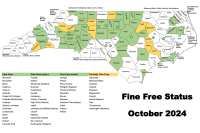Winging it
It’s that time of year again when passing fronts will mean passing visitors at Lake Junaluska. Waterfowl were riding the cold winds that kicked up on Thanksgiving.
A quick turn around the lake on Friday morning (Nov. 23) revealed 10 species of ducks. There was a raft of over 30 buffleheads, the most I have ever seen at one time on Lake Junaluska. The other nine species were wood duck (a pair), gadwall (6 or more), green-wing teal (4 or more), northern pintail (1), redhead (4 or More), ring-necked duck (numerous), lesser scaup (4 or more), hooded merganser (numerous) and ruddy duck (10 or more).
The thing about migration and fronts, though, is here today gone tomorrow. Most of the buffleheads, redheads and scaup that were seen Friday were gone Saturday morning. More birds have come and gone on successive fronts since then.
A few more redheads have dropped in and on Wednesday (11/28) there was a raft of about 15 lesser scaup and a raft of gulls that numbered around 20. Most of the gulls were ring-billed but there appeared to be a couple of smaller gulls. Bonaparte’s had been noted earlier that week by Bob Olthoff.
Ring-necked ducks, hooded mergansers and ruddy ducks have been hanging around at the lake for a while. There will probably be some of these species on the lake from now till spring migration.
It’s a banner year at the lake for American coots. Coots are common winter residents at the lake but I don’t think I’ve ever seen them in such numbers. It looks like it was also a banner year for aquatic vegetation at the lake — I think elodea — and that may have something to do with the large number of coots.
Related Items
The daunting task of counting all those coots will fall on Bob’s shoulders Dec. 29, the date of this year’s Carolina Field Birders’ annual Christmas Bird Count. I’m a little concerned because I don’t think he’s got enough fingers and toes. I wouldn’t be surprised if the tally was over 500.
That many coots may draw the attention of some hungry passers-by. Coots are a preferred prey of bald eagles. I saw one immature and one mature bald eagle at the lake last winter. So if you’re out there counting waterfowl, remember to look up.
And a short ps — It looks like the winter finch invasion I wrote about last week has reached the mountains of Western North Carolina. Blair Ogburn, senior naturalist at Balsam Mountain Preserve, called last Friday (Nov. 30) to say she had common redpolls at the nature center at BMP.
And another tidbit ‘ a couple of weeks ago George Ivey of the Bethel community called to say he had a wayward rufous hummingbird at his place.
And I had a new yard bird just the other evening — a great-horned owl. It looks like it’s shaping up to be an interesting winter.









